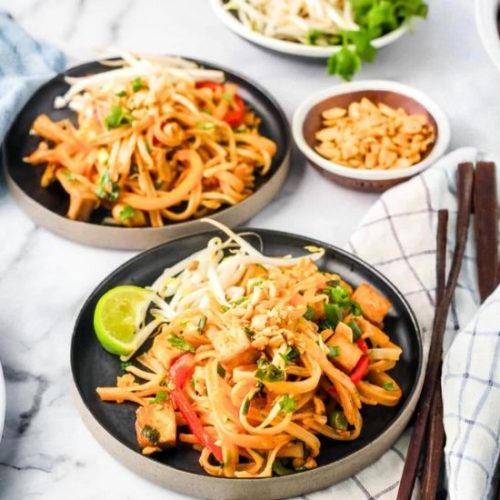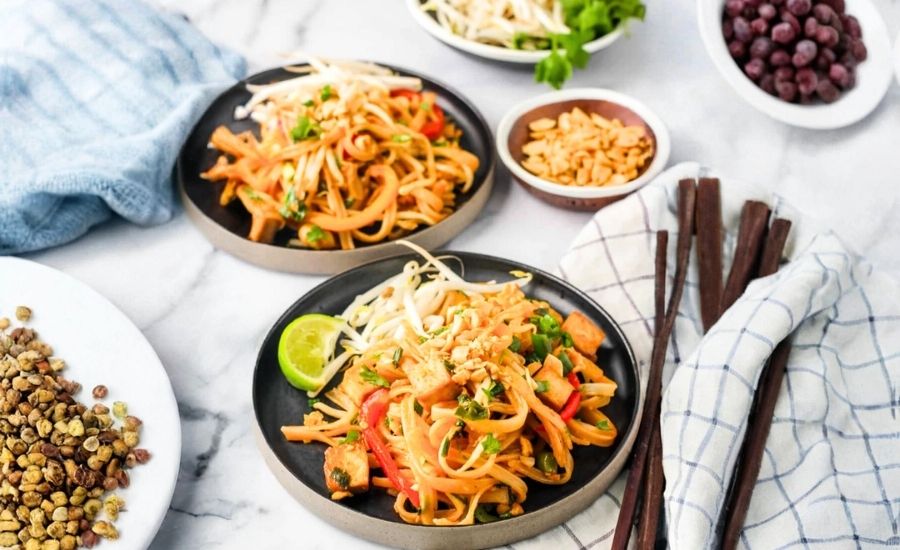All products are selected by our editorial team for quality. If you buy through our links, we may earn a small commission at no extra cost to you.
Vegetarian Pad Thai is a vibrant, flavorful dish that stands out for its balance of textures and nutrient-packed ingredients.
This recipe features protein-rich extra firm tofu, delivering a hearty boost while keeping the meal vegetarian.
The use of rice noodles offers a gluten-free, low-fat carbohydrate base, making it suitable for many diets.
Loaded with colorful bell peppers, scallions, and bean sprouts, it’s a fiber-rich meal brimming with vitamins A and C, promoting overall health and digestion.
With a modest amount of healthy fats from oil and peanuts, plus eggs adding additional protein and richness, this dish offers a well-rounded nutritional profile.
It’s quick to prepare—ready in just 30 minutes—making it ideal for busy weeknights or meal prep.
The recipe’s flexibility to bake, air fry, or pan-fry tofu also adds convenience.
The tangy, sweet, and spicy Pad Thai sauce ties everything together, creating a satisfying and wholesome dish that appeals to the whole family.
Must-Have Tools for Perfect Results
Wok
Essential for stir-frying vegetables, tofu, and noodles evenly at high heat.
Its deep, sloped sides allow for quick tossing and prevent spills, making it versatile for many Asian dishes and everyday sautéing.
Large Mixing Bowl
Perfect for soaking and separating rice noodles to prevent clumping.
A sturdy bowl is a kitchen staple, useful for marinating, mixing doughs, and preparing salads.
Tongs
The ideal tool for tossing noodles and ingredients together without breaking delicate rice noodles.
Tongs also provide better control when handling food in the wok or serving.
Measuring Spoons
Accurate measurement of the Pad Thai sauce ingredients ensures consistent flavor balance.
High-quality measuring spoons are essential for precise cooking and baking at home.
Baking Sheet (optional)
Useful for baking tofu evenly to achieve a crispy texture without added oil.
Baking sheets are multipurpose, great for roasting vegetables, baking cookies, and more.

Authentic Vegetable Pad Thai
Equipment
- 1 large wok or deep frying pan
- 1 large mixing bowl (for soaking noodles)
- Measuring spoons (for sauce ingredients)
- Tongs (for mixing and serving)
- Baking sheet (for baking tofu; optional)
Ingredients
- 14 oz extra firm tofu prepared by baking
- 8 oz rice noodles linguine style recommended
- 5 cups water for soaking noodles
- 3 tablespoons vegetable oil divided
- 1 tablespoon fresh garlic finely minced
- 1 bunch scallions separated into white and green parts
- 1 small red bell pepper thinly sliced
- 1 small yellow bell pepper thinly sliced
- 2 large eggs lightly beaten
- 6 oz Pad Thai sauce store-bought or homemade
- 3 cups fresh bean sprouts
- ½ cup roasted peanuts coarsely chopped
- ½ cup fresh cilantro finely chopped
- ½ lime cut into four wedges
Instructions
- Prepare the Tofu: Start by baking the extra firm tofu to achieve a firm texture with a slightly crisp surface.You can also opt to air fry or pan-fry it if preferred. Set aside once cooked.
- Soak the Rice Noodles: Bring 5 cups of water to a rolling boil. Place the rice noodles in a large heat-safe bowl, then pour the hot water over them. Stir gently with a fork to separate the noodles and prevent sticking. Allow to soak for about 10 minutes, or according to package instructions. Drain and reserve.
- Chop the Vegetables: While the noodles soak, prepare your vegetables. Slice the white parts of the scallions into thin strips and chop the green tops finely, setting them aside separately. Thinly slice the red and yellow bell peppers into slender strips.
- Stir-Fry Aromatics and Vegetables: Heat half of the oil in a large wok over high heat. Add minced garlic, white scallion strips, and both colors of bell pepper. Stir-fry for 2 minutes, until the garlic becomes fragrant and vegetables start to soften. Push the veggies to one side of the wok.
- Cook the Eggs: Add the remaining oil to the center of the wok. Pour in the beaten eggs and scramble gently until cooked but still moist. Then mix them with the cooked vegetables.
- Combine Noodles, Tofu, and Sauce: Add the drained rice noodles, baked tofu pieces, and the Pad Thai sauce to the wok. Using tongs, toss everything together thoroughly to coat the noodles evenly with the sauce. Cook for 2 to 3 minutes until everything is heated through.
- Add Fresh Ingredients and Serve: Stir in the bean sprouts, half of the chopped green scallions, half the peanuts, and half the cilantro.Mix well. Plate the Pad Thai and garnish with the remaining scallions, peanuts, cilantro, and lime wedges on the side. Serve immediately while hot.
Notes
- For the Pad Thai sauce, we recommend Maesri brand for an authentic flavor, available in many Asian markets or online.
- If using Thai Kitchen Pad Thai sauce, which tends to be sweeter, consider adding a tablespoon of chili garlic paste to add balance and spice.
- You can make your own sauce by gently simmering together soy sauce, light brown sugar, tamarind paste, water, and chili garlic sauce until thickened.
- Rice noodles vary by brand and thickness—always check the soaking or cooking instructions on the package for best results.
- Baking tofu beforehand helps it maintain a firm texture and absorb flavors better than raw tofu.
Chef’s Secrets for Authentic Flavor
Achieving an authentic and delicious Vegetarian Pad Thai comes down to a few key techniques and ingredient choices.
Baking the tofu before adding it to the stir-fry enhances its texture, giving it a firm, slightly crispy exterior that holds up well amidst the saucy noodles.
Don’t skip soaking the rice noodles properly—this step ensures they’re tender but not mushy and prevents clumping during cooking.
When stir-frying, using a wok over high heat helps quickly cook the ingredients, preserving the vibrant color and crunch of the vegetables.
The balance of flavors in the Pad Thai sauce is critical: tangy tamarind, savory soy, a touch of sweetness, and a hint of spice create the perfect harmony.
Feel free to adjust the sauce’s heat and sweetness to suit your palate. Finally, adding fresh herbs, peanuts, and lime just before serving provides a refreshing contrast in texture and flavor that elevates the dish.
Serving Suggestions to Impress Everyone
This Vegetarian Pad Thai shines as a complete meal on its own, but pairing it thoughtfully can elevate your dining experience.
Serve it alongside light Asian-inspired appetizers such as fresh spring rolls or a crisp cucumber salad for a refreshing contrast.
If you want to add more greens, a side of steamed or sautéed bok choy seasoned with garlic complements the flavors beautifully.
For drinks, a cold jasmine tea or a light, crisp white wine like Sauvignon Blanc pairs nicely with the dish’s tangy and spicy notes.
Garnishing generously with fresh cilantro, chopped peanuts, and lime wedges not only adds texture and brightness but also lets each person customize their bowl to taste.
This dish works wonderfully for casual family dinners or even more elegant gatherings due to its vibrant presentation and bold flavors.
Storage Tips for Freshness and Flavor
Leftover Pad Thai stores well, making it a convenient option for meal prep or next-day lunches.
To preserve the texture and flavor, store the noodles and sauce mixture in an airtight container in the refrigerator for up to 3 days.
Keep fresh toppings like bean sprouts, peanuts, cilantro, and lime wedges separate until ready to serve, as they can lose their crunch and brightness when refrigerated.
When reheating, gently warm the Pad Thai in a skillet over medium heat with a splash of water or oil to prevent drying out, stirring frequently to maintain even heat.
Avoid microwaving directly, as it can make the noodles sticky and chewy.
If you want to freeze leftovers, it’s best to freeze only the noodles and tofu without fresh vegetables or herbs, and consume within one month for best quality.
Frequently Asked Questions Answered Clearly
1. Can I make this recipe vegan?
Yes! Simply omit the eggs or replace them with scrambled tofu or a plant-based egg substitute. The dish will still be flavorful and satisfying.
2. What’s the best way to cook tofu for this dish?
Baking tofu is recommended for a firm texture that holds well in stir-fries. Press the tofu first to remove excess moisture, then bake at 400°F (200°C) for about 25 minutes, flipping halfway through.
3. Can I use other types of noodles?
You can substitute with other rice noodles or even thin wheat noodles, but cooking times and soaking methods may vary. Always check package instructions for best results.
4. How spicy is this dish, and can I adjust the heat?
The traditional Pad Thai sauce has a mild to moderate heat level.
You can increase spice by adding chili garlic sauce or fresh chili peppers, or reduce it by using less spicy sauce or omitting chili altogether.
5. What if I can’t find tamarind paste?
If tamarind paste isn’t available, a mix of lime juice and a bit of brown sugar can approximate the tangy-sweet flavor, but the depth of tamarind is unique.
Alternatively, some Asian stores sell tamarind concentrate or ready-made Pad Thai sauces that include it.
This recipe is inspired by ministryofcurry and has been carefully refined to enhance clarity, streamline preparation steps, and ensure accurate results. We’ve also included health benefits, nutritional highlights, and Must-Have Tools to help you get the best results every time you cook.


